Reflection on the 2021 Multiple Choice Exam
On May 4th, a Exam for Trimester 3 and reviewing for the AP Exam was opened and it was a Multiple Choice Test on CollegeBoard with 70 Questions and this is my reflection as well as any test corrections
Taking the Multiple Choice Test
We were assigned a 50 Question Multiple Choice Test in preparation for the AP Exam and we know what to expect on that day. This was assigned on a Friday, but we had until the next Monday to finish it. Many of my groupmates had started it and I worked with some of them to get maybe the first 15 questions done, but I had to I did this pretty quickly and finished quicker than expected and when I submitted I got a 64/67 (92.9%).
Test Corrections
After I submitted the test, I got 65/70 (93%), and I was surprised that I only got five problems wrong, most of the questions were easy but I did not know how to answer them some of them, especially ones that were about Big Idea 4. I did get an A, but I should also work on improving those other concepts. This means I should work harder towards trying to understand why I got these questions wrong and remember them. Whenever I got questions wrong, they were usually from the same skill showing that I could use some practice in specific skills.

1.A: 1/1 (100.0%)
1.B: 1/1 (100.0%)
1.C: 2/3 (66.7%)
1.D: 12/12 (100.0%)
2.A: 4/4 (100.0%)
2.B: 12/13 (92.3%)
3.A: 2/2 (100.0%)
3.B: 2/3 (66.7%)
3.C: 1/1 (100.0%)
4.B: 5/5 (100.0%)
4.C: 2/3 (66.7%)
5.A: 4/4 (100.0%)
5.B: 4/4 (100.0%)
5.C: 3/3 (100.0%)
5.D: 2/2 (100.0%)
5.E: 8/9 (88.9%)
I can take a look at the notes I took for each section, especially from the ones I got wrong. If I don’t understand it from my notes, I can always go back to the CollegeBoard Videos and rewatch it. Additionally, when I was doing test corrections I could look at the reason why my answer was wrong, and why the correct answer was right.
Question 14
Topic 1.4: Identifying and Correcting Errors Topic 3.10: Lists 3.12: Calling Procedures
Explanation for Wrong Answer: B, By making this change, the procedure will immediately return true any time it encounters a value that is greater than or equal to the preceding value. It will not check any subsequent values in the list.
Explanation for Correct Answer: C, As is, the procedure traverses numberList from left to right and returns true whenever it encounters a value that is less than the preceding value. If it never encounters such a value, false is returned. This has the effect of returning true whenever the list is not increasing and returning false whenever the list is increasing, which is the opposite of what is intended. By interchanging lines 8 and 12, the procedure will return true or false appropriately.
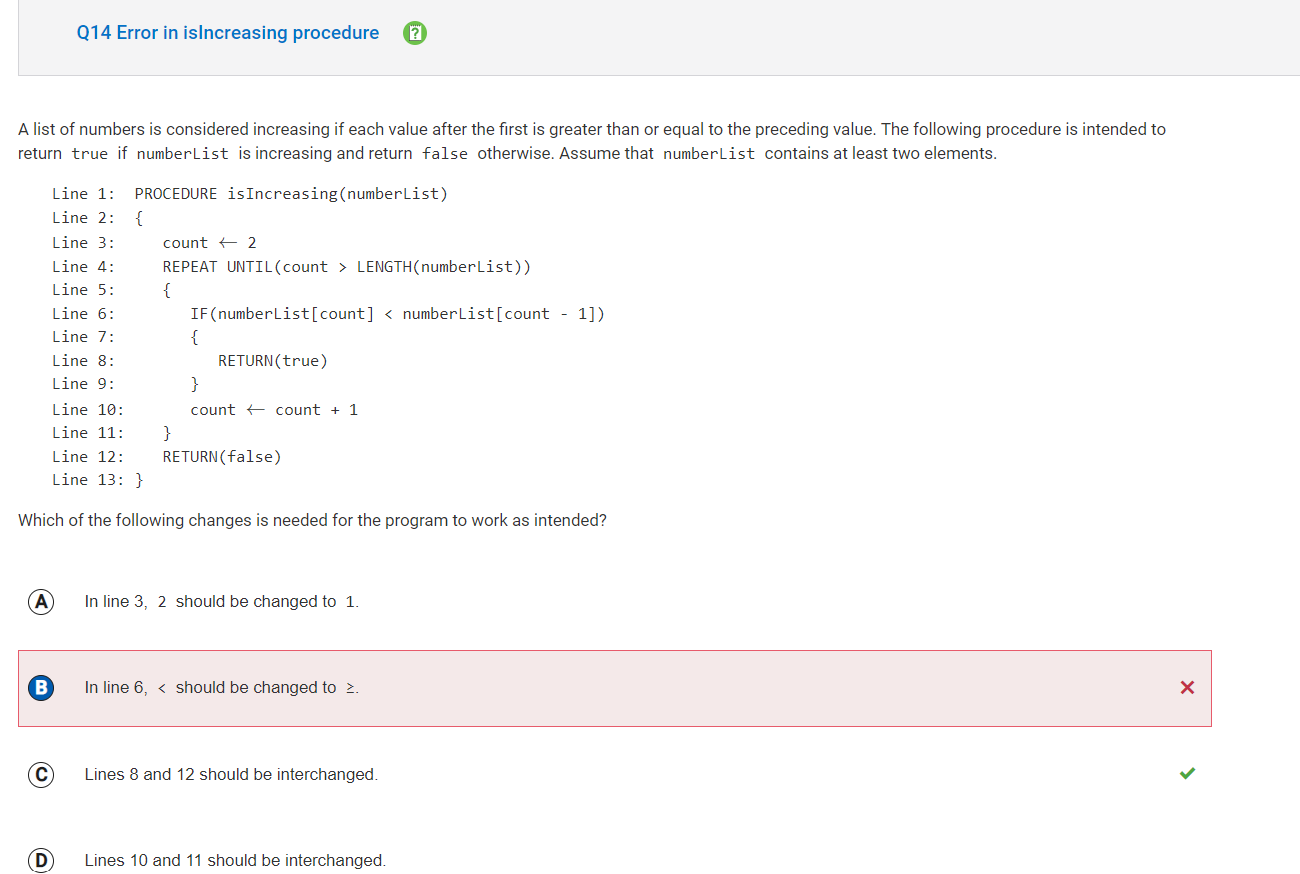
Question 15
Topic 3.8: Iteration Topic 3.12: Calling Procedures
Explanation for Wrong Answer: D, This code segment draws five horizontal line segments, starting with the segment from (5, 0) to (10, 0) and ending with the segment from (5, -4) to (6, -4).
Explanation for Correct Answer: A, This code segment starts at the coordinate (1, 0). Inside the loop, a call to drawLine draws a vertical line segment of length len. By increasing xVal by 1 inside the loop, the next line segment will be drawn one position to the right. By increasing len by 1 inside the loop, the next line segment drawn will have its length increased by one. This has the effect of drawing the line segments shown in the figure from left to right.
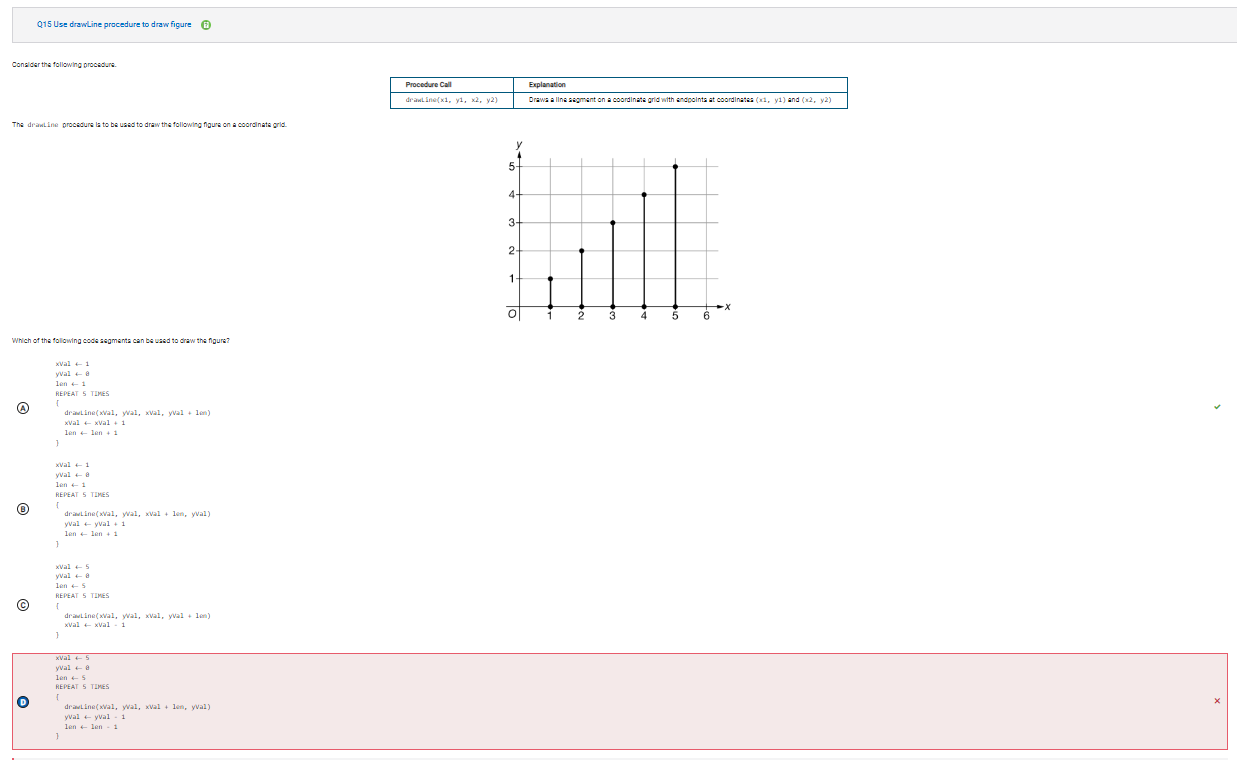
Question 50
Topic 5.6: Safe Computing
Explanation for Wrong Answer: D, Symmetric encryption uses a single key. Public key encryption uses a public key for encryption and a private key for decryption.
Explanation for Correct Answer: A, Symmetric encryption uses a single key for both encryption and decryption of data. Since the key can be used to unlock the data, it should be kept secret.
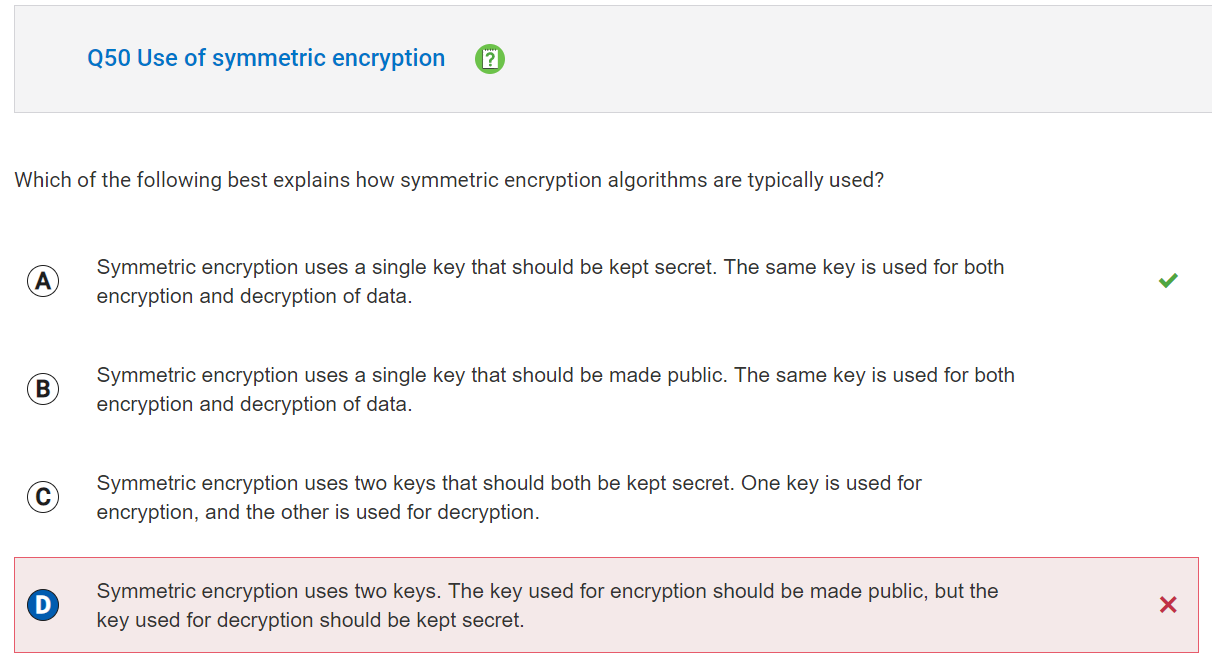
Question 51
Topic 5.4: Crowdsourcing
Explanation for Wrong Answer: B, This project can be done by a small team of researchers and is not likely to require a distributed approach.
Explanation for Correct Answer: A, Citizen science is scientific research conducted in whole or part by distributed individuals, many of whom may not be scientists, who contribute relevant data to research using their own computing devices. This project would benefit from using a citizen science model for gathering photographs of birds from amateur photographers around the world.
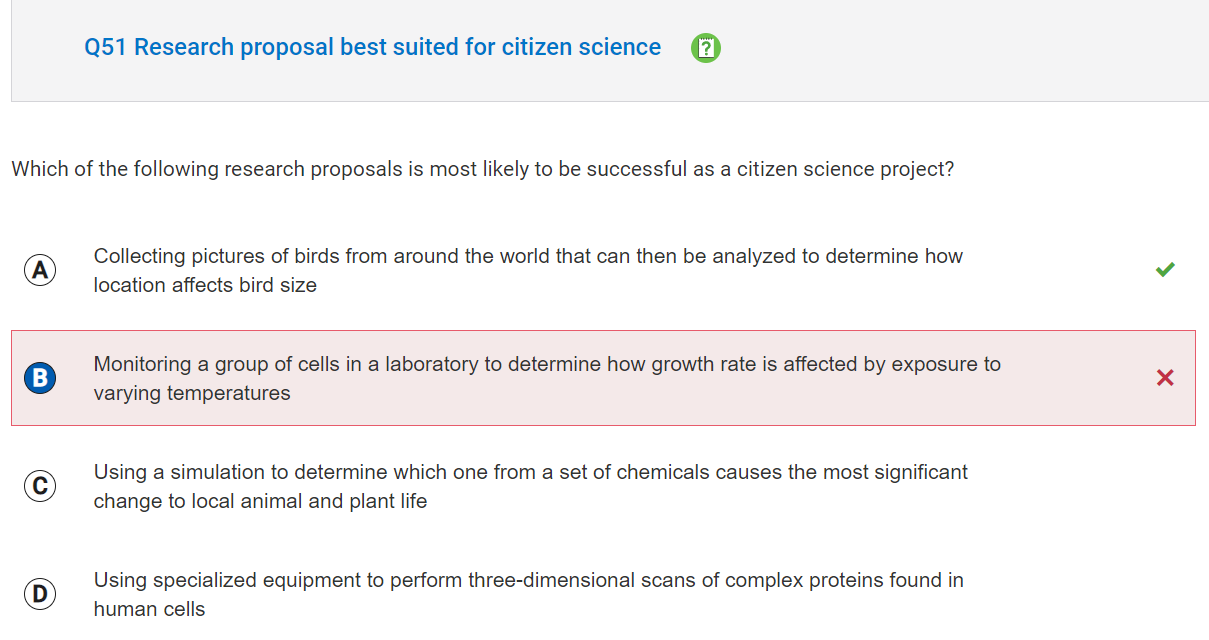
Question 63
Topic 3.5: Boolean Expressions
Explanation for Wrong Answer: A and C, When input1 and input2 are both true, the expressions (NOT input1) and (NOT input2) are both false, so (NOT input1) OR (NOT input2) will evaluate to false. In all other cases, either (NOT input1) or (NOT input2) (or both) will evaluate to true, so (NOT input1) OR (NOT input2) will evaluate to true. For example, when input1 is true and input2 is false, then (input1 OR input2) will be true. Therefore, NOT (input1 OR input2) will be false instead of the intended value true.
Explanation for Correct Answer: A and D, When input1 and input2 are both true, the expressions (NOT input1) and (NOT input2) are both false, so (NOT input1) OR (NOT input2) will evaluate to false. In all other cases, either (NOT input1) or (NOT input2) (or both) will evaluate to true, so (NOT input1) OR (NOT input2) will evaluate to true. When input1 and input2 are both true, the expression (input1 AND input2) is true, so NOT (input1 AND input2) will evaluate to false. In all other cases, (input1 AND input2) will evaluate to false, so NOT (input1 AND input2) will evaluate to true.
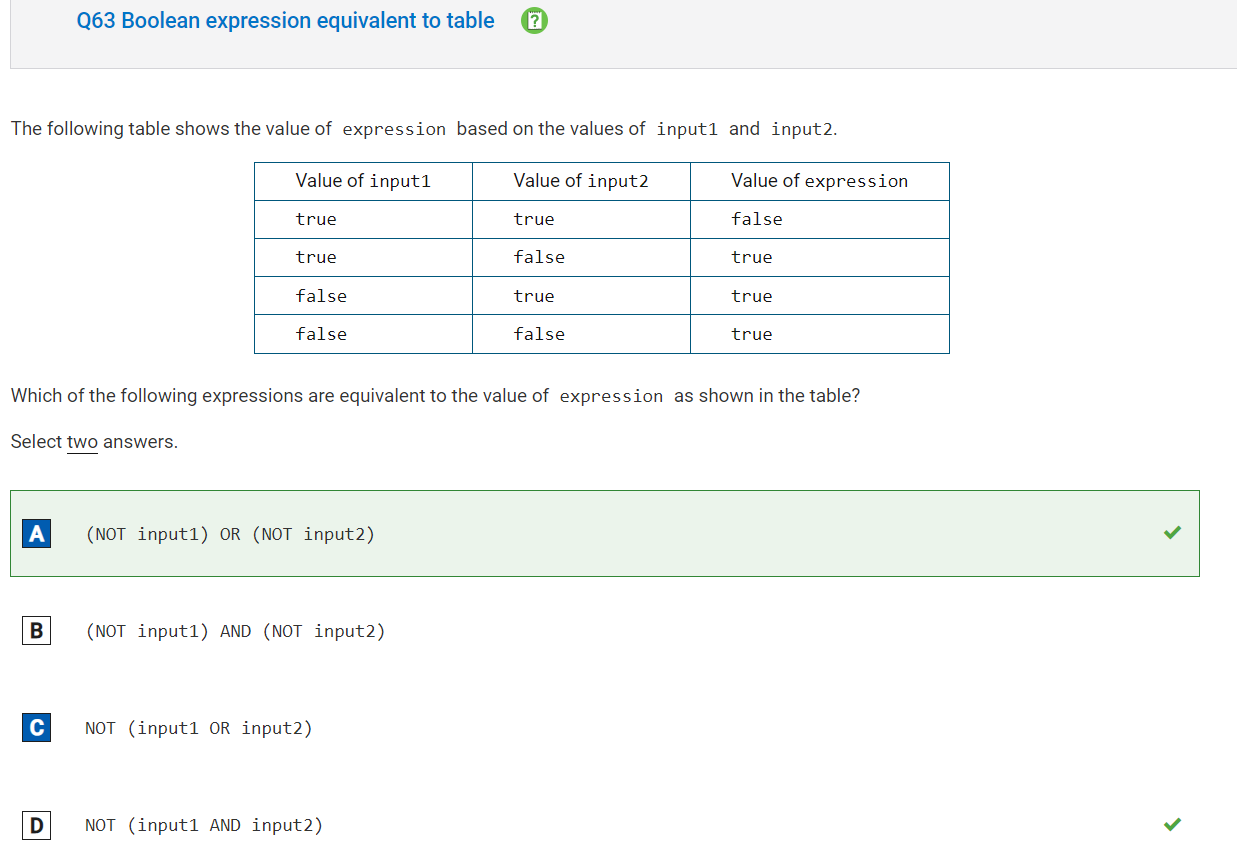
Confusing Problems
Question 2
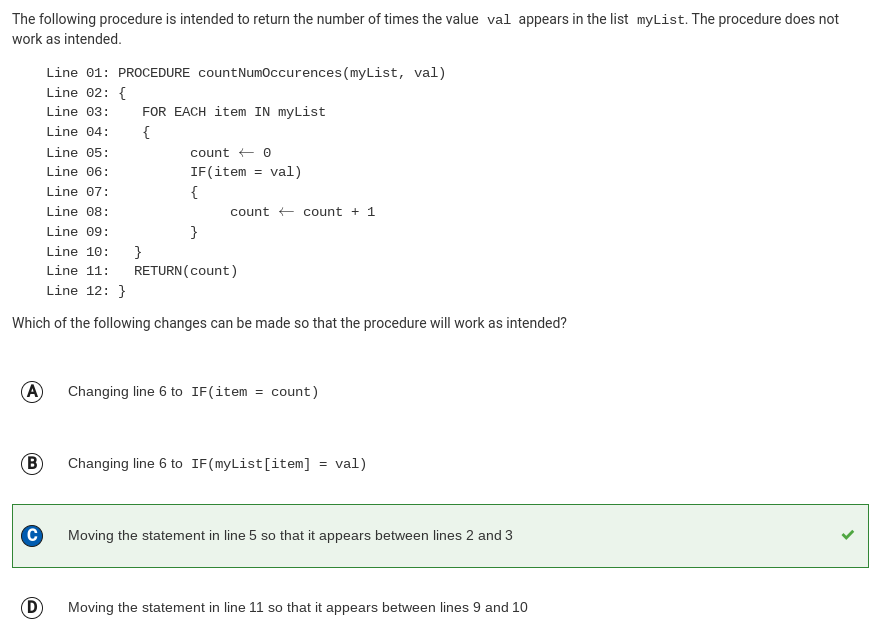
I did not understand the purpose of the program and I had to try and guess what could be changed in order to find out the answer. On this question, I had to guess the answer because I did not know what would make sure the output of the code would stay the same.
Question 16
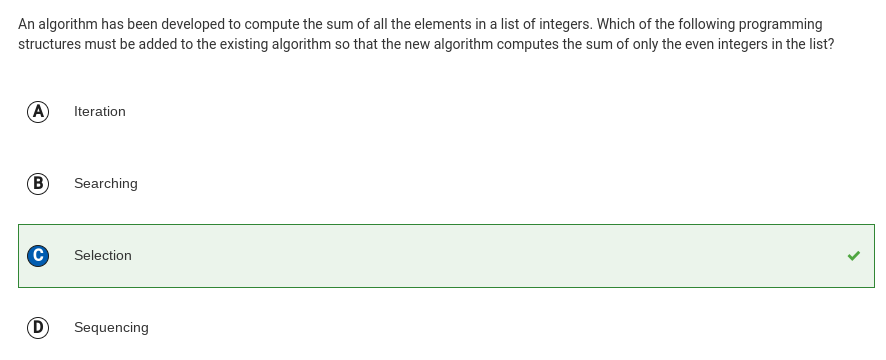
This question was a complete guess because I had no idea what each one meant completely, I had an idea of each one, but I wasn’t sure why the answer was selection, I knew it couldn’t be iteration because that would help with the even number, and I had to guess between the other three choices, and I was right. I still do not understand but maybe I can understand by looking at someone else’s test corrections.
Question 30
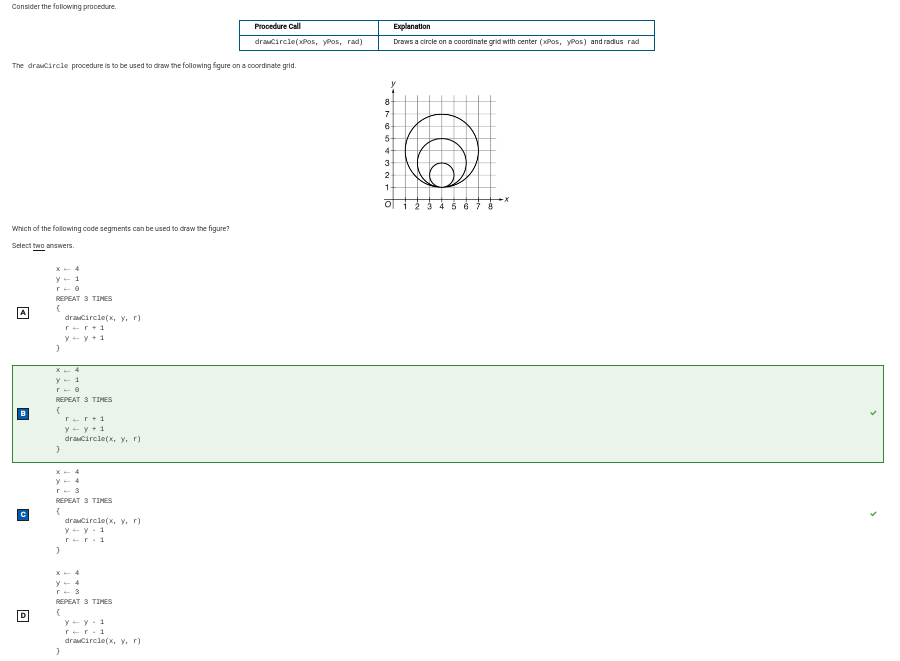
This question was very hard and I did not really understand what the question was asking and I had no idea what I had to do. I got this question right but I did not know why it was B and C, all I knew was that it was not A or D because the circles did not line up.
Reflection on the Exam
Overall, the test was pretty easy and I am happy with ny score, but I should try to get a higher score. If I paid attention a little more, I think I could have understood the questions a bit more I think I went through this test pretty slowly because I did not really understand each question and I had to read it a lot of times. I think I can do well on the AP Exam if I find out what exactly I need to do and keep reviewing the content, spend less time on each problem.